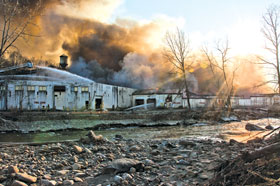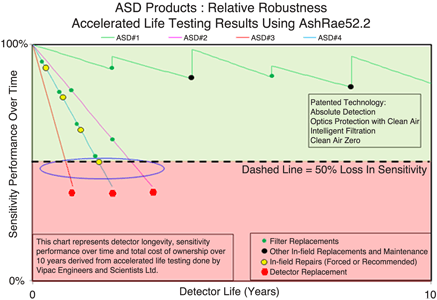

In the final article, we conclude the application of aspirating smoke detection in harsh environments and the importance of selecting the correct technology.
Since these systems actively draw in air, together with whatever contamination exists within the environment, the management of this contamination is essential. Minimising the impact on the equipment requires good physical filtration. Unless this is addressed correctly contamination will ultimately compromise performance and the serviceable life of the equipment.
With the increase in ASD products globally, each manufacturer has developed various ways in which to deal with contamination. Some detectors draw in 100% of the environment air without filtration, relying on complex algorithms and other measures to manage dust contamination. Others use minimal or basic mechanical filtration methods and only apply pre-filters in applications that really warrant it.
Any aspirating smoke detector not designed for the environment will draw in contaminated air and, without the proper filtration, will experience the effects.
Pre-filters have become a part of engineered ASD systems used in many hostile environments. However there is one important fact that must be kept in mind: pre-filters are not monitored. When they accumulate a certain level of contamination they will not allow smoke to be drawn to the detector. This phenomenon is termed smoke attenuation. The pre-filters can become contaminated to such an extent that only air will pass through. It is difficult to say how long this phenomenon will continue before an actual air flow fault is raised, since all ASD systems are different.
It will also depend upon the type of contamination. A time frame anywhere from a week to months is not unusual. The issue arises when the maintenance regime applicable to the pre-filters is not strictly followed. The required level and frequency of maintenance depends upon the application and the environmental conditions, but the underlying concern is that a period of time can pass where the ASD system will not effectively detect smoke.
The answer is a specific detector which incorporates a monitored intelligent filter within a purpose-built detector designed with contamination in mind.
ASD system maintenance
Because of the different environments and conditions, the degree of preventive maintenance for each system must be considered in line with the type of contamination and concentration level within the area. Environments with low levels of background contamination may only require preventive maintenance as set down by the manufacturer. However, where contamination levels are more severe additional preventive maintenance will be required.
In addition to the detector and pipe network, attention must also be given to any other ancillary equipment associated with the system, for example:
* Chemical pre-filtration. Media must be checked and changed regularly.
* Water traps/coalescing filters/driers. These must be checked periodically to monitor either water build-up or evaporation.
* Back flushing. A practice regularly implemented to clean the pipe network in hostile environments. This equipment may either be manual or automatic and any components associated with this will need servicing.
Maintenance can be conducted by the original installer or an authorised distributor or well-trained service contractor. Industrial sites will require a more rigid level of maintenance and service than cleaner applications.
Are all ASD systems suitable?
This is a question that can only be answered after the proper evaluation of the various ASD products available. Having stated that any fire detection equipment used in hostile environments will suffer the effects of contamination, it is important to recognise that even amongst ASD products all is not necessarily equal. Each manufacturer’s equipment must be carefully analysed to ensure suitability for the application and conditions.
Hughes Associates Inc (Fire Science & Engineering) (HAI) in the United States conducted a webinar in 2012, Testing & Verification of ASD Products in Different Environments. HAI witnessed and verified the testing of several manufacturers’ ASD products.
Testing was undertaken to assess ASD performance under different environments. Several product brands were tested with varying results. Not only were products tested for clean environments, but also for industrial environments. With industrial application testing the focus was on determining the performance of ASD as a technology in these environments by evaluating:
* Detection performance in moderately high airflow environments.
* Test performance of ASD with automatic alarm threshold adjustment algorithms to slow smoke growth scenario.
* Test performance of ASD in moderately low ambient background smoke levels.
* Test ASD long-term performance to the impact of contamination on hardware.
* Comparative assessment of detection response to smoke and dust sources.
In a further attempt to establish the suitability of ASD products in industrial or hostile environments VIPAC engineers and scientists also conducted some testing of a number of current ASD products. The testing was very specific, relating to ‘Accelerated Life Testing’ using Ashrae 52.2 standardised loading conditions (dust).
Four ASD products were chosen and tested. The detectors selected were those where the respective manufacturers market their products as being suitable for use in industrial environments and conditions which could be considered harsh or hostile.
Subsequent to the VIPAC testing the chart in Figure 1 was developed to indicate the results. The outcome is surprising and certainly shows that not all detectors will offer the same performance when exposed to dust. The four detectors tested have been indicated only as ASD #1, #2, #3 and #4.

Testing showed that detector #3 had a relatively short life cycle and could only sustain operation over a short period before replacement was required. Detector #4, whilst having a slightly longer life cycle, did require both frequent filter replacement and repairs. Repairs typically relate to aspirator and/or sensing chamber diminished performance or failure. Detector #2 experienced better performance than #4 and #3 although its life cycle was also less than desirable. Only one detector, #1, showed that it could sustain a substantial life cycle and at the same time deal with the effects of dust.
Perhaps the most critical aspect of this testing is that of deteriorating detector sensitivity. Three out of the four detectors showed significant sensitivity loss during testing. This is certainly a major concern when selecting equipment for these environments. After all, this is about detecting fires early and effectively.
So, what is the aim of all this? The results of any independent third party testing are to establish the suitability of fire detection equipment to do its job in the application and environment for which it is intended. Educating practitioners about the correct selection of any product, including ASD, can only lead to better installed and performing systems with ultimately less likely problems and nuisance alarms.
Summary
Air sampling smoke detection has come a long way since its inception. Today there are many global manufacturers with a host of products. The detector is only one part of an ASD system. Managing performance in both clean and difficult/dirty environments with this technology requires knowledge and experience.
To provide the best possible fire protection for an industrial environment means firstly selecting the correct technology and product which must be purpose-built and be able to withstand the conditions on site, providing efficient and effective contamination management. The detector must maintain its sensitivity over its life cycle and provide a low total cost of ownership. A practical and cost-effective design which includes the pipe network is also a significant factor if the system is to offer performance with low maintenance.
Most importantly, the system must be installed, commissioned and maintained correctly with follow-ups checks to make the necessary adjustments that were either known or unexpected at the design stage. A good system, designed with adequate capacity will be able to be fine-tuned post-installation to ensure the expected performance for the end user.
Finally, ASD systems can perform in industrial environments, but should only be designed and installed by those with knowledge and experience.
Paul Leslie has over 35 years’ experience in both security and fire, 20 of which have been spent in aspirating smoke detection. Leslie, the current chair of the Fire Protection Association (Aust) – Queensland Div. Committee has a dedicated interest in the fire industry and strong involvement in the association. He also serves on several Australian standards committees. His knowledge and expertise has involved the global design and support of ASD systems in many wide and varied applications.
For more information, contact Derek Waddell, regional sales manager, Xtralis, +27 (0)82 316 2601, dwaddell@Xtralis.com
© Technews Publishing (Pty) Ltd. | All Rights Reserved.